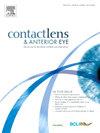高度非球面眼镜与角膜塑形镜2年近视控制效果比较。
IF 4.1
3区 医学
Q1 OPHTHALMOLOGY
引用次数: 0
摘要
目的:比较高度非球面镜片(HAL)和角膜塑形镜片(OK)治疗儿童近视的两年疗效。方法:回顾性分析温州医科大学附属眼科医院1683例HAL患者和1192例OK患者的病历。参与者为8-13岁的儿童,屈光误差为-0.50 ~ -6.00 D。他们按年龄分为小(8-10岁)组和大(11-13岁)组,并进一步分为低近视眼(-0.50 ~ -3.00 D)和中度近视眼(结果:在小年组中,HAL在1岁(HAL: 0.16±0.19 mm;OK: 0.22±0.17 mm;结论:在低龄低近视儿童中,HALs比OK镜片更有效地控制AL延伸,而两种治疗方法在年龄较大的儿童中显示相似的效果。对于中度近视,首选OK型镜片,以获得较好的长期控制效果。本文章由计算机程序翻译,如有差异,请以英文原文为准。
Comparison of two-year myopia control efficacy between spectacle lenses with highly aspherical lenslets and orthokeratology lenses
Purpose
To compare the two-year efficacy of spectacle lenses with highly aspherical lenslets (HAL) and orthokeratology (OK) lenses in managing myopia in children.
Methods
This retrospective study examined medical records from the Affiliated Eye Hospital of Wenzhou Medical University, involving 1683 HAL users and 1192 OK users. Participants were children aged 8–13 with a refractive error of −0.50 to −6.00 D. They were divided by age into younger (8–10 years) and older (11–13 years) groups and further divided into low myopia (−0.50 to −3.00 D) and moderate myopia (<-3.00 to −6.00 D) subgroups. The participants were included in either the 1-year or 2-year follow-up group based on the length of their follow-up records. The change in axial length (AL) was compared between the HAL and OK groups using t-tests and multiple linear regression analysis.
Results
In the younger group, HALs yielded significantly slower AL elongation than did the OK lenses at both the 1-year (HAL: 0.16 ± 0.19 mm; OK: 0.22 ± 0.17 mm; p < 0.001) and 2-year follow-ups (HAL: 0.32 ± 0.27 mm; OK: 0.37 ± 0.24 mm; p = 0.009). In the older group, the AL changes did not significantly differ by lens at the 1-year (p = 0.782) or 2-year (p = 0.239) follow-up. Among the low myopia subgroup, the HAL users consistently exhibited smaller AL changes than did the OK users across all follow-ups (p < 0.05), except at the 2-year follow-up in the olders (p = 0.414). For the moderate myopia subgroup, the OK lenses yielded significantly slower AL changes at the 2-year follow-up (younger: p = 0.013; older: p = 0.01), although no significant differences were found at the 1-year follow-up (younger: p = 0.635; older: adjusted: p = 0.143).
Conclusions
HALs are significantly more effective than OK lenses in controlling AL elongation in younger children with low myopia, while both treatments show similar effectiveness in older children. For moderate myopia, OK lenses are preferred for superior long-term control.
求助全文
通过发布文献求助,成功后即可免费获取论文全文。
去求助
来源期刊

Contact Lens & Anterior Eye
OPHTHALMOLOGY-
CiteScore
7.60
自引率
18.80%
发文量
198
审稿时长
55 days
期刊介绍:
Contact Lens & Anterior Eye is a research-based journal covering all aspects of contact lens theory and practice, including original articles on invention and innovations, as well as the regular features of: Case Reports; Literary Reviews; Editorials; Instrumentation and Techniques and Dates of Professional Meetings.
 求助内容:
求助内容: 应助结果提醒方式:
应助结果提醒方式:


